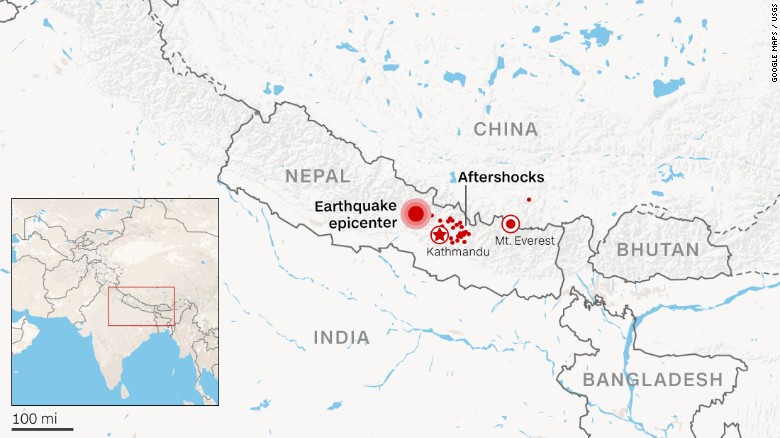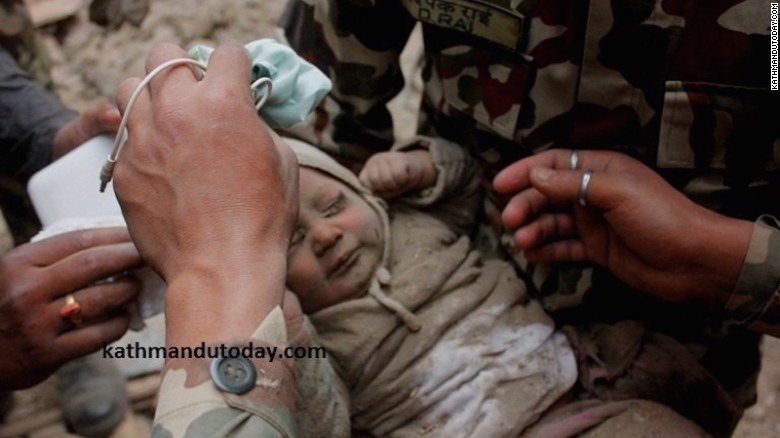 Updated 0455 GMT (1155 HKT) April 30, 2015
Updated 0455 GMT (1155 HKT) April 30, 2015
Kathmandu, Nepal (CNN)-Half a million tents are urgently needed for the huge number of people forced from their homes by Nepal's devastating earthquake, a government minister said Wednesday.
Minendra Rijal, Nepal's minister of information and communications, said relief operations were underway but that much more needs to be done.
"Life is returning to normal, but it will be some time to be completely normal," he said. "We have still not been able to properly manage to provide relief."
Rijal wasn't able to put a precise number on those made homeless by Saturday's devastating quake, but he said the government had so far provided more than 4,700 tents and 22,000 tarpaulins to those in need of shelter.
Aircraft loaded with tents are expected from India and Thailand in the next day, he said, with another 100,000 tents expected from Pakistan.
Two UNICEF flights arrived Wednesday with supplies such as water-purification tablets, family hygiene kits and tents and tarps.
UNICEF Regional Communication Advisor Jean-Jacques Simon said the supplies "are desperately needed by those living in camps, and other areas in Kathmandu, the Kathmandu Valley and in hard-to-reach remote areas, where UNICEF plans to distribute the items as soon as possible."

Map of Nepal earthquake epicenter and aftershock locations
The United Nations has said the quake has affected 8 million people across 39 districts.
Rijal said 21 helicopters, including seven provided by India, were helping in the rescue and relief efforts, with 866 people rescued by air and a little more than 1,000 rescued using land transport.
As rescue workers seek to reach people who desperately need help, the weather is making things worse.
Heavy rain has intensified the hardships for the countless Nepalis who are sleeping out in the open because their homes were destroyed or they don't feel safe inside buildings amid continuing aftershocks.
At Tundhikal Park, known now as Tent City, the crowds are thinning, but it's not necessarily a sign of improvement.
On Wednesday, some had enough of sleeping huddled in a tent and were readying to return to their houses. That's the correct term -- houses; they were no longer homes, no longer places of sanctuary.
U.S. President Barack Obama called Prime Minister Sushil Koirala on Wednesday to express condolences, the White House said. This is the first time Obama has spoken with the Prime Minister since Saturday's first earthquake.
Obama and he talked about disaster response efforts and Obama pledged that the United States "will do all that it can to help the people of Nepal in their time of need," the White House said.
Vital supplies
In the district of Gorkha, where the magnitude-7.8 quake was centered, a large storm rumbled over the mountainous terrain Tuesday afternoon.
"That essentially shut down helicopter missions for the entire afternoon, except for a small window before sunset," Matt Darvas, an emergency communications officer for the humanitarian group World Vision, told CNN on Wednesday. He's currently in the main town in Gorkha.
But signs of improvement can be found.
Outside the walls of Ranta Park's tent city, the streets are beginning to come back to life. Small groups work together to clear sidewalks and roads of rubble after the earthquake. Cars and motorbikes buzz down the streets, while shops reopen for business. Street vendors are out once again.
But Ranta Park is still a grim place There are few signs of activity here, as families wait for some change in the status quo.
Makeshift field hospital
Some 5,489 people were confirmed dead as of Wednesday evening as a result of the massive earthquake, with another 11,440 injured, Nepal's National Emergency Coordination Center told CNN. Officials have warned the death toll is expected to rise.
Some 5,489 people were confirmed dead as of Wednesday evening as a result of the massive earthquake, with another 11,440 injured, Nepal's National Emergency Coordination Center told CNN. Officials have warned the death toll is expected to rise.
Nineteen of the deaths occurred on Mount Everest, where the tremors set off deadly avalanches, the Nepal Mountaineering Association said.
Two neighboring countries, India and China, have reported totals of 72 and 25 deaths from the quake, respectively.

CNN has obtained powerful photos showing a four-month-old baby boy rescued underneath rubble at least 22 hours after a magnitude-7.8 earthquake centered less than 50 miles from Kathmandu rocked Nepal with devastating force Saturday, April 25. The earthquake and its aftershocks have turned one of the world's most scenic regions into a panorama of devastation.

Katmandu Today, a Nepalese newspaper, photographed the rescue and writes the infant was rescued by the Nepalese Army and is in stable condition with initial examinations showing he has no internal injuries.
The frequent downpours in Nepal have made it harder for emergency workers to help the injured.
CNN's Dr. Sanjay Gupta was at an army field hospital in Kathmandu when the heavens opened Tuesday.
"The rain has arrived, and in many cases, this is the worst-case scenario," he said. "This is what they were hoping wouldn't happen."
Gupta said it was "kind of remarkable what they've been able to do" at the makeshift hospital. Over three days, the medical staff there had treated 617 patients and saved 586 of them.
Monsoon looms
The rain has also increased the risk of landslides and mudslides across rugged terrain already destabilized by the earthquake's tremors.
Two landslides were reported Tuesday afternoon in the Langtang region, a popular trekking area north of Kathmandu. As many as 200 people were feared to be missing in each of the landslides, officials said.
Foreigners are among the missing from one of them, said Gautam Rimal, a senior official in Rasuwa district. He said 210 people had been rescued from the area Wednesday by government helicopters.
Peter Bodde, U.S. ambassador to Nepal, said via Twitter on Wednesday that four U.S. citizens trapped in Langtang were among those rescued and that they were on their way to Kathmandu.
According to army officials, dozens of foreigners are among those saved from the Dhunche area, near Langtang, in the past three days. Other victims, including foreigners, still wait to be brought out.
Many people are stuck at the main town in Gorkha, unable to reach their families in villages cut off by the earthquake.
They include Kumar Gurung, a 37-year-old man who has had no word from his wife and four children since the hours after the quake, according to Darvas.
Gurung was on his way to a town 80 kilometers (about 50 miles) away for an animal health training course when the earthquake threw his plans into chaos.
Now he can't get back to his village, Singla, which is perched on a mountain above a cliff face and would take days to reach after landslides blocked roads. Before he lost contact with them, the people in his village told him that at least 70% of the dwellings in the village had been destroyed.
Darvas said that Gurung told him: "I am incredibly sad about this situation and want to rescue not just my family but all of my friends in the village, but I don't know what to do or how to reach them."
Local leaders in the main town in Gorkha are "absolutely exhausted and totally stretched" as they try to deal with the crisis in their district, Darvas said.
Their difficulties are being shared by other officials across Nepal. An influx of international aid is struggling to find its way to many of the people in need. Officials have reported logjams at Kathmandu's airport as well as on the way to badly affected areas.
In Kathmandu, where the quake felled temples and homes across the city of more than 1.7 million, many people are desperately trying to return to their family homes in the countryside.
The situation has led to angry outbursts at times.
One 13-year-old girl, Manushi, who joined protests Wednesday in Kathmandu, told CNN that too little was being done to help.
The 14 people in her family were getting only one plate of food for every two of them, she said.
On Tuesday, a squad of riot police was deployed in response to a short-lived effort to block traffic as part of a demonstration.
Protesters were shouting "down with the government" and accusing authorities of not doing enough to stop bus companies from hiking their prices. They also complained the government hadn't done enough to help victims of the disaster.
Police officials said Wednesday that they had deployed troops to help manage the throngs of people seeking transportation out of town and that there had been some reports of looting but no serious breakdown in order.
"People just want to get home," said Pushparam KC, a spokesman for Nepal's Armed Police.
But those people were much better off than those cramming the wards in nearby hospitals.
Rishi Khanal, 27, had just undergone surgery and was resting, surrounded by family and friends. He had been buried under the rubble for 82 hours before a French rescue team pulled him out Tuesday. His rescue took several hours, and Nepalese police posted a video of it on YouTube.
Khanal had spoken briefly to a few reporters but on this afternoon, he could not. He was too distraught and too feeble. His foot was crushed and his relatives did not want him to relive the trauma of having survived buried for more than three days.
But he was alive. A sign of hope in a hospital full of despair.
CNN's Manesh Shrestha, Moni Basu and Oren Liebermann reported from Kathmandu, Jethro Mullen reported and wrote from Hong Kong, and Laura Smith-Spark wrote in London. CNN's Elizabeth Joseph, Ivan Watson, Sugam Pokharel, Khalil Abdallah contributed to this report.
No comments:
Post a Comment